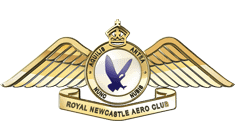
1950 – 1960
A large ex RAAF Bellman hangar was erected adjacent to the main hangar at Broadmeadow, giving the Club much greater space for housing its growing fleet.

1950 – 1960
A large ex RAAF Bellman hangar was erected adjacent to the main hangar at Broadmeadow, giving the Club much greater space for housing its growing fleet.
Club aircraft performed sterling services through out disastrous floods on the North Coast also in 1950. Six aircraft and pilots were engaged in flood relief work at Kempsey and Grafton dropping tons of stores, blankets, and medical supplies. Nine different dropping zones were used and more than 2500 miles were logged.
The Club was recognized as the largest Aero Club in the Southern Hemisphere during 1951. Its network of training centres and its large fleet of aircraft had made it the most famous aviation organization in Australia. The longest flight yet undertaken by a Club aircraft was made during 1951 when Club Instructor, Russ Evans, flew a Dragon containing Newcastle Surf Club personalities to the Surf Championships in Perth, Western Australia.
The 3rd President, E. (Erle) A. Pengelly was elected during 1951.
1953 was a major year for the Aero Club. The Queen granted permission for the prefix ‘Royal’ to be affixed to the Club’s name. The new title was a great honor for Newcastle as it was the first time a non-capital city had been awarded this as recognition of contribution to the services, particularly to the RAAF in training pilots both pre-war and currently for national service.
During 1953, the Governor, Sir John Northcott, visited Broadmeadow aerodrome to unveil an Honor Roll inscribed with the names of 69 club members who served in World War II. Sir John paid a tribute to the Club for its work in training pilots, he said in his address “here we have what is possibly the greatest Aero Club in the British Empire”.
At this period the club operated 40 aircraft, employed 12 full time flying instructors, and 8 honorary instructors. The permanent staff of engineers totaled 24. The Club’s total membership was 1700 with 560 in Newcastle and the remainder in the 37 affiliated country centres.
Also during this period the club received a special citation from the commissioner of Police in NSW for its outstanding services performing flood relief flying. He said ‘Royal Newcastle Aero Club is internationally known and is making a major contribution to the prestige of Newcastle throughout the world.
The area covered by the training organisation was now 120,000 square miles. Administration was all undertaken at Headquarters at Broadmeadow.
Early in 1954 the Club received a blow when it was announced by the Government that all elementary training for RAAF National Service would be performed at Bankstown, NSW, instead of being farmed out to Aero Clubs. Mr Preston, Club Manager, prophesied a loss to the Club of 10,000 pounds in revenue. He said irrespective of the number of pilots under training, the Club’s overhead expenses continued.
Towards the end of 1954 Mr. L Plumstead was appointed Manager of RNAC on the retirement of Mr. S Preston, and Mr. Russ Evans became CFI. The Club was again called on during the massive floods of 1955 to assist in relief flying such as dropping supplies to marooned farmers. Club aircraft flew over 400 hours during these operations.
Club pilots flew 4 Tiger Moths from Brisbane to Broadmeadow during 1955. They were released from RAAF disposals and bought the club’s Tiger Moth fleet to 22 of these popular Air Force trainers.
The 4th President, H. (Howard) Williams was elected during 1955.
In 1956 the Government imported a large batch of ex RAF Chipmunk trainers for aero clubs. RNAC took delivery of 10 of these machines, bringing its total to 12, and the Chipmunk commenced to replace Tiger Moths as basic trainers.
During 1957 4 Chipmunks, an Auster and a Dragonfly, flown by Club members, undertook a long flight from Broadmeadow to Hobart in Tasmania visiting and annual 3 day Regatta. CFI Russ Evans resigned from his position with the Club to take up flying duties with Qantas Airlines. Lou Plumstead became Manager / CFI and the Social Club was formed. During this period the Aero Club took over the now defunct Maitland Aero Club’s mortgage on the airfield at Rutherford and became owner of this airfield, which eventually would become the Club’s new home.
The decision was made to commence withdrawal from the country centres as they had become uneconomical. Each country branch was assisted and encouraged by RNAC to take over a Club aircraft and set up their own organization. Many of them flourished.

